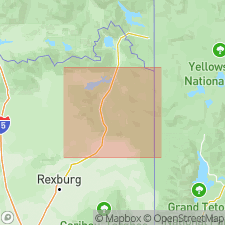
- Usage in publication:
-
- Big Bend Ridge Rhyolite*
- Modifications:
-
- Named
- Dominant lithology:
-
- Rhyolite
- AAPG geologic province:
-
- Snake River basin
Summary:
Named, probably for Big Bend Ridge, Fremont Co, ID in Snake River basin. Consists of four informally named rhyolite flows present on the rim and outer flanks of Island Park between Big Bend and Thurmon Ridges: Bishop Mountain, Green Canyon, Blue Creek, and Headquarters flows. The thicknesses of the flows varies greatly; is 375 m thick at the exposure on the caldera scarp at the base of Bishop Mountain, Fremont Co, ID, which is designated the type area. Headquarters flow overlies the Blue Creek flow, but the stratigraphic relations among the other are unclear. All of these flows overlie the Huckleberry Ridge Tuff and underlie the Mesa Falls Tuff on the rim west of Island Park. The Big Bend Ridge flows are roughly similar to each other in petrology and lithology. All contain phenocrysts of quartz, sanidine, and plagioclase. Most of the flow surfaces are eroded, but sperulitic zones are preserved widely. Mafic silicate minerals in the crystallized rocks commonly are altered to iron-oxide minerals; biotite occurs in the Bishop Mountain and Green Canyon flows and, as such, is notable because biotite is generally absent in rhyolites of the Yellowstone Plateau field. Source vents for the flows are unknown but buried somewhere in the Island Park basin--probably in the ring-fracture zone of the first-cycle caldera. Big Bend Ridge, though not yet dated directly, is considered to be earliest Pleistocene [based on magnetic polarity of flows].
Source: GNU records (USGS DDS-6; Denver GNULEX).
For more information, please contact Nancy Stamm, Geologic Names Committee Secretary.
Asterisk (*) indicates published by U.S. Geological Survey authors.
"No current usage" (†) implies that a name has been abandoned or has fallen into disuse. Former usage and, if known, replacement name given in parentheses ( ).
Slash (/) indicates name conflicts with nomenclatural guidelines (CSN, 1933; ACSN, 1961, 1970; NACSN, 1983, 2005, 2021). May be explained within brackets ([ ]).

